Well it looks like I summarised the main new species announced in 2008 (see last weeks post) way too early! Greg Finch advised that he is obtaining a new species that Steve Nunn has called Selenotholus Queensland which may turn out to be the only true Selenotholus in Queensland after reclassification of the genus is completed. I have obtained permission from Steve Nunn to post the picture below that he took of this species.
This species grows to 18 cm (males 16 cm) and its closest relative is Selenotholus sp. Black. Thanks to Greg Finch and Steve Nunn for this information.
Subscribe to:
Post Comments (Atom)







Not sure how important this information is, but in 1989 I found a spider seeming to match the description of the Selenotholus sp. in the boot of my car in Sydney's northern suburbs. It was about 20cm long and 12cm wide as it sat in a resting state. I was studying biology at Macquarie University at the time and described it to my lecturer. She was very surprised and said there was no known spiders in Australia matching such a description. I have always just assumed that it was someones pet African Tarantula that may have escaped. Now it seems that I may have discovered it before it was known. This also implies that the spider exists in Sydney and has existed here for quite some time. Is this information useful? What are your thoughts?
ReplyDeleteThinking back to 1989, it was possible that the spider had somehow crawled into my car when I was visiting Queensland but that means the spider would have been hiding in my car for weeks or even months before I saw it on the inside of my boot, which incidentally was next to my quilt that I had slept in the night before... I know you like these guys, but forgive me if I feel a little uneasy about that thought!! Otherwise there may be a variety living around Lane Cove National Park. Let me know if anyone else has ever found one there or if you think it is likely to have come from Queensland.
ReplyDelete